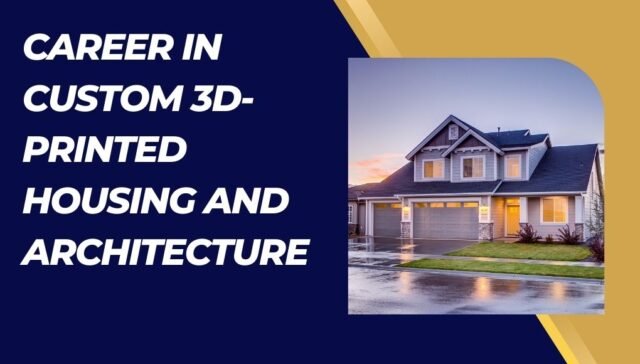The advent of 3D printing technology has revolutionized various industries, with architecture and housing being at the forefront of this transformation. Custom 3D-printed housing offers innovative solutions to traditional construction challenges, paving the way for sustainable, efficient, and cost-effective building methods. As this technology continues to evolve, it opens a plethora of career opportunities for professionals eager to be part of this groundbreaking field.
Careers in 3D-printed housing industry,
Custom 3D-printed architecture jobs,
Skills required for 3D-printed construction,
Future of 3D-printed housing careers,
Innovations in 3D-printed architecture.
Table of Contents
- Introduction to 3D-Printed Housing and Architecture
- The Rise of Custom 3D-Printed Housing
- Key Technologies in 3D-Printed Construction
- Career Opportunities in 3D-Printed Housing and Architecture
- Top Universities Offering Courses in 3D Printing and Architecture
- Further Reading
1. Introduction to 3D-Printed Housing and Architecture
3D printing, also known as additive manufacturing, involves creating three-dimensional objects by adding material layer by layer based on digital models. In architecture and construction, this technology enables the creation of complex structures with precision, reducing waste and labor costs. The integration of 3D printing in housing allows for rapid prototyping, customization, and the use of sustainable materials, addressing the growing demand for affordable and eco-friendly living spaces.
2. The Rise of Custom 3D-Printed Housing
The global housing crisis has necessitated innovative solutions to meet the increasing demand for affordable and sustainable homes. Custom 3D-printed housing has emerged as a viable solution, offering:
- Speed: Significantly reduced construction times compared to traditional methods.
- Cost-Effectiveness: Lower labor and material costs due to automation and precision.
- Design Flexibility: Ability to create complex and customized designs with ease.
- Sustainability: Minimized waste and the potential use of recycled or locally sourced materials.
Companies worldwide are investing in 3D printing technology to construct homes, schools, and commercial buildings. For instance, ICON, a construction technologies company, has been at the forefront of developing 3D-printed homes in the United States.
3. Key Technologies in 3D-Printed Construction
Understanding the technologies driving 3D-printed construction is crucial for those aspiring to enter this field. Key technologies include:
- Robotic Arm Extruders: Utilized for precise layering of construction materials.
- Concrete Printing: Specialized 3D printers that extrude concrete mixtures to build structural components.
- Large-Scale 3D Printers: Machines capable of printing entire building sections or complete structures.
- Advanced Software: Design and simulation tools that facilitate complex architectural designs and structural analysis.
Companies like WASP have developed large-scale 3D printers tailored for architectural applications, enabling innovative construction methods.
4. Career Opportunities in 3D-Printed Housing and Architecture
The integration of 3D printing in construction has led to the emergence of various specialized roles. Key career opportunities include:
- 3D Architectural Designer: Focuses on creating digital models tailored for 3D printing, ensuring structural integrity and aesthetic appeal.
- 3D Printing Technician: Operates and maintains 3D printing equipment, ensuring optimal performance during construction processes.
- Materials Engineer: Develops and tests new materials suitable for 3D printing in construction, emphasizing sustainability and durability.
- Project Manager: Oversees 3D-printed construction projects, coordinating between designers, engineers, and clients to ensure timely and within-budget completion.
- Quality Control Specialist: Ensures that 3D-printed structures meet all safety standards and design specifications.
Job prospects in this field are expanding globally. For instance, companies like Azure Printed Homes are seeking 3D Printer Technicians to advance their construction projects.
5. Top Universities Offering Courses in 3D Printing and Architecture
Pursuing specialized education can provide a competitive edge in this evolving field. Notable institutions offering relevant programs include:
- Massachusetts Institute of Technology (MIT): Offers courses focusing on the fundamentals of 3D printing, covering various technologies and materials.
- Penn State University: Provides an online Master of Engineering in Additive Manufacturing and Design, exploring the transformative role of additive manufacturing across sectors.
- Carnegie Mellon University: Offers a Master of Science in Additive Manufacturing, emphasizing hands-on experience with current AM technology.
- The University of Nottingham: Provides an advanced Master of Science program in Additive Manufacturing and 3D Printing, designed to impart in-depth knowledge and skills related to additive manufacturing technologies.
- Institute for Advanced Architecture of Catalonia (IAAC): Offers a Postgraduate program in 3D Printing Architecture, focusing on additive manufacturing of sustainable architecture.
6. Further Reading
For those passionate about exploring the intricacies of 3D-printed housing and architecture, the following resources offer comprehensive insights and the latest developments:
- “The Future of 3D Printed Buildings” – An in-depth look at how 3D printing technology is shaping the future of architecture and construction, with a focus on sustainability and innovative design. (archdaily.com)
- “3D Printing in Architecture: Design and Innovation” – A detailed analysis of how architects are leveraging 3D printing for custom designs and complex geometries. (designboom.com)
- “Global Market Trends in 3D Printing Construction” – A report detailing market growth, leading companies, and investment trends within the 3D-printed construction industry. (marketsandmarkets.com)
- “Additive Manufacturing in Architecture” – An academic paper exploring the implications of additive manufacturing in modern architectural practices. (researchgate.net)
7. Challenges and Future Prospects in 3D-Printed Housing and Architecture
While the field of 3D-printed housing and architecture is rapidly growing, it faces several challenges:
- Regulatory and Building Codes: Many countries have yet to update their building codes to accommodate 3D-printed structures, slowing the adoption of this technology.
- Material Limitations: The development of durable, sustainable, and cost-effective materials suitable for 3D printing remains a challenge.
- Initial Investment Costs: The high cost of industrial 3D printers and materials can be a barrier for small-scale construction companies.
- Skilled Workforce Shortage: A lack of trained professionals proficient in both 3D printing technology and architectural design creates a gap in the industry.
Future Prospects:
- Increased Adoption in Developing Countries: Custom 3D-printed housing is expected to play a significant role in addressing housing shortages in developing regions.
- Advancements in Material Science: Ongoing research into sustainable and eco-friendly construction materials will enhance the durability and appeal of 3D-printed structures.
- Integration with Smart Home Technology: The growing demand for smart homes presents opportunities for integrating IoT (Internet of Things) solutions within 3D-printed buildings.
- Growth of Modular Construction: Modular 3D-printed components are anticipated to revolutionize commercial construction by enabling rapid assembly and customization.
8. Tips for Pursuing a Career in 3D-Printed Housing and Architecture
Aspiring professionals can follow these steps to build a successful career in this innovative field:
- Acquire Relevant Education: Pursue a degree in architecture, civil engineering, or industrial design with a focus on additive manufacturing.
- Gain Hands-on Experience: Intern or work with companies specializing in 3D-printed construction to learn about the latest technologies and practical applications.
- Develop Technical Skills: Master CAD (Computer-Aided Design) software, 3D modeling, and simulation tools to enhance your design capabilities.
- Stay Updated on Industry Trends: Follow industry news, attend conferences, and participate in workshops to stay informed about advancements in 3D-printed housing.
- Build a Professional Network: Connect with architects, engineers, and 3D printing experts through networking platforms like LinkedIn and industry events.
- Showcase Your Portfolio: Create a digital portfolio showcasing your designs, prototypes, and completed projects to attract potential employers or clients.
9. Industry Leaders and Innovators in 3D-Printed Housing
Several pioneering companies are leading the 3D-printed construction industry with groundbreaking projects and technological advancements. Notable names include:
- ICON: Renowned for building the first 3D-printed community in the U.S., ICON focuses on sustainable housing solutions. (iconbuild.com)
- Winsun: A Chinese company known for printing multi-story buildings using large-scale 3D printers and recycled construction materials. (winsun3d.com)
- Apis Cor: Specializes in mobile 3D printers that can print an entire house on-site within 24 hours. (apis-cor.com)
- Mighty Buildings: Utilizes a unique composite material to produce prefabricated modular homes. (mightybuildings.com)
- COBOD: Focuses on commercial 3D construction printers, contributing to the development of various residential and commercial projects worldwide. (cobod.com)














